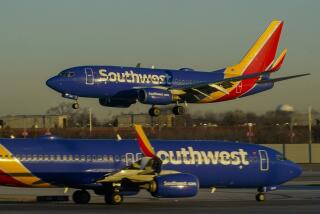THE EASTERN BANKRUPTCY : The Game Plan : Airline Moves to Restore Some Flights
- Share via
NEW YORK — Eastern Airlines, operating under the cover of bankruptcy law, moved Friday to restore some of its flights even as it continues to face the pickets of striking machinists and the anger of ticket holders seeking refunds for canceled flights.
On Friday, the airline said its shuttle flights in the New York-Washington-Boston corridor were packed with passengers lured by bargain $12 one-way fares.
This weekend, Eastern said, 40 round-trip flights on other routes will be restored. The carrier said it will resume flying to 13 of the 18 cities it serves in Central and South America.
Before the weeklong walkout by its machinists and pilots and the carrier’s Chapter 11 bankruptcy filing Thursday, Eastern operated 1,040 flights a day.
“This is the beginning of a new, smaller, restructured and viable Eastern Airlines,” Eastern Chief Executive Phil Bakes said in a prepared statement. “We will continue to expand operations in prudent, substantial increments.”
Eastern said it will begin its new schedule on Sunday with service to Latin America from Miami. On Monday, Eastern will operate three daily round trips between Miami and San Juan, Puerto Rico; one round trip each between Miami and LaGuardia Airport in New York and between LaGuardia and Montreal; and 14 daily round trips between between Boston and Washington. Eastern is also operating a full schedule of 62 shuttle flights each weekday.
Eastern officials said there will be enough personnel to fly the planes needed for the announced schedule because some pilots who had honored the pickets of striking machinists are now seeking to return to work. The union representing pilots strongly denied that claim.
Spokeswoman Cori Zywotow said that as of Thursday, when the bankruptcy filing had been made, Eastern had 200 pilots who flew the shuttle and one three-day-a-week flight to South America.
“Since then, the pilots have been calling in and asking how to report back to work,” she said. “We have more than enough pilots to fly the new schedule.” However, managers were still filling in for striking mechanics, baggage handlers and other ground personnel, she said.
Some analysts noted that pilots came back to work at Continental Airlines, Eastern’s sister carrier under the ownership of Texas Air Corp., when Continental was placed in Chapter 11 bankruptcy in 1983--apparently out of fear of losing their jobs.
Ray Neidl, analyst with the New York brokerage McCarthy, Crisanti & Maffei, said the availability of pilots “is much tighter” now. Nevertheless, he added, pilots who move to another airline must start at the lowest seniority level and accept much lower pay.
But the Eastern Air Line Pilots Assn. disputed the notion that enough of its members are crossing picket lines so that the airline can increase its schedules. Rather, the union said, the number of pilots reporting for work was “decreasing.”
In a statement, the Air Line Pilots Assn. said Eastern had fewer than 100 pilots available for flight operations, a number that has remained virtually unchanged since the beginning of the machinists’ strike, and that some of those pilots are management personnel.
ALPA also charged that the company has “stepped up its campaign to threaten, coerce and otherwise entice pilots to cross (machinist picket lines). This includes illegal offers of bonuses for second officers, which are in particularly short supply, and phone calls to pilots’ homes, attempting to intimidate pilots, their spouses and even their children, with threats that their breadwinner will never be able to work again for Eastern.”
A ruling late Thursday by a federal bankruptcy judge effectively cleared the way for Eastern to continue its operations. The judge gave the airline permission to pay its working employees but made no provision for paying workers who are honoring machinists’ picket lines.
Lawyers for the machinists said they will mount a legal battle to get wages owed to striking union members. While the airline reorganizes under bankruptcy court protection, a federal judge must approve all of the company’s expenditures and transactions.
The new crowds on Eastern’s shuttle came after the carrier held out the lure of special fares for business travelers during the week and $12 on weekends. Previously, shuttle traffic had been almost non-existent with some flights carrying as few as six passengers. The shuttle normally flies between 4,000 and 6,500 passengers daily.
By Friday morning, an Eastern spokeswoman said, planes were half-filled and by the afternoon they were going out full.
On other routes where Eastern had maintained a strong presence, competitors were picking up some business. But other airlines were making no extraordinary efforts to profit from Eastern’s difficulties by adding extra flights or routes--primarily because they already had plenty of seats available on existing flights to accommodate extra passengers and because they don’t have aircraft or crews to spare.
The carrier adding the most flights was Continental--on routes to Florida from Newark, LaGuardia and Washington’s National Airport.
Delta Air Lines spokesman James Lundy said his carrier has available for sale 63,000 seats out of Atlanta each day and those flights average about 60% full. On its entire system, Delta’s flights are 50% full. “As you can see, we have plenty of space available,” he said. He said Delta is adding two flights this weekend to San Juan to accommodate cruise ship passengers.
American Airlines was also adding several flights this weekend to San Juan for the same reason.
In other Eastern matters, a federal judge in New York extended indefinitely his temporary ban to prevent railroad workers from striking in sympathy with airline workers. The ban imposed by U.S. District Judge Robert P. Patterson Jr. will stay in place until he renders a final decision.
Meanwhile, White House spokesman Marlin Fitzwater told reporters Friday that the White House staff was continuing to monitor the situation but that President Bush “is not rethinking” his decision to stay out of the strike.
“I’ve not heard any discussions” of changing policy and invoking the federal law that would allow a 60-day cooling off period in the strike, Fitzwater said.
“We are disappointed that they haven’t been able to work out an agreement with the unions,” he said, “but otherwise, I don’t think we have any comment at this point.”
More to Read
Sign up for Essential California
The most important California stories and recommendations in your inbox every morning.
You may occasionally receive promotional content from the Los Angeles Times.













